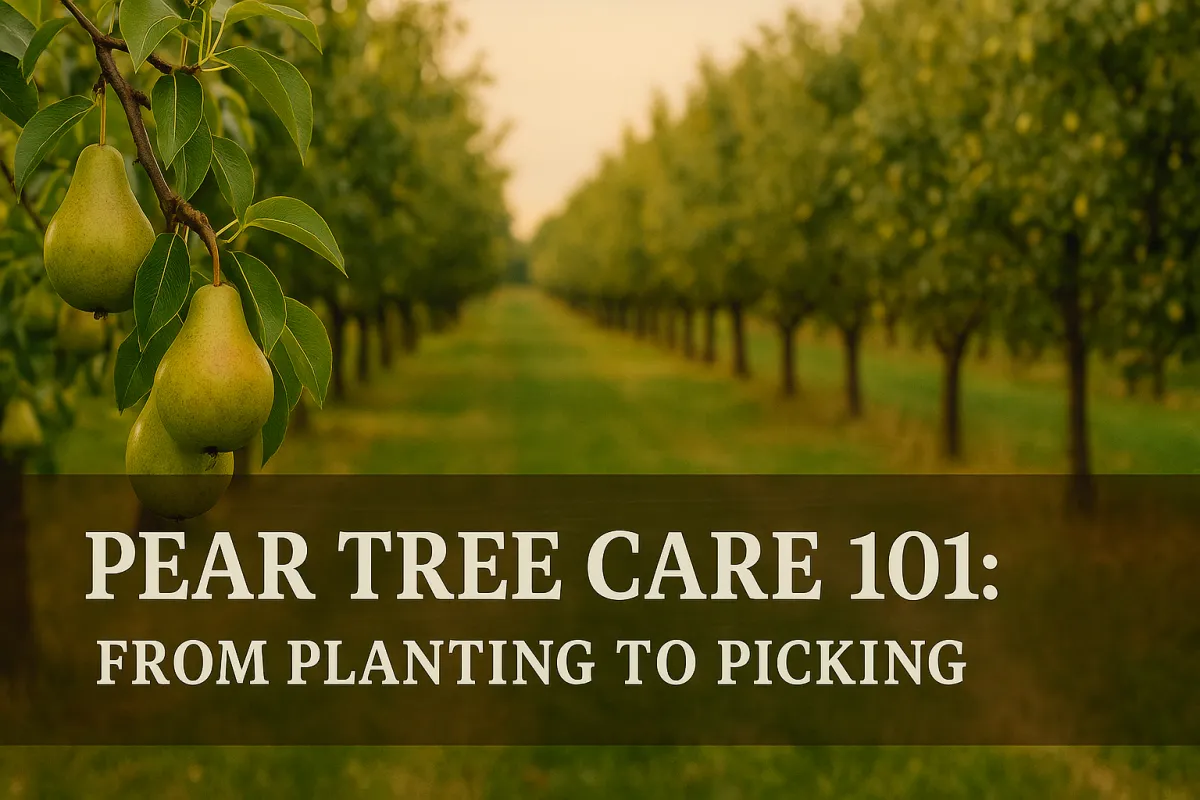
Pear Tree Care 101: From Planting to Picking
Lessons From the First Pear Tree
When I planted my first pear tree, I thought it would be as simple as digging a hole, dropping it in, and waiting for fruit. A few years later, the tree was tall but bare. No blossoms, no pears—just a reminder that fruit trees don’t hand out shortcuts. Pears are generous trees when they’re set up right, but if you miss the fundamentals—pollination, planting depth, pruning—you’ll wait years for little return.
That early mistake taught me a lesson: pears aren’t complicated, but they do demand respect. With a little planning, you can plant once and harvest for decades. Let’s walk through what it takes—from choosing varieties to picking ripe fruit.
Choosing the Right Pear Varieties
European vs. Asian Pears
Pears generally fall into two families.
European pears (think Bartlett, Bosc, Comice) ripen off the tree. They’re soft, sweet, and store well in cool storage. Perfect for canning, baking, and eating fresh if you don’t mind waiting a bit for ripeness.
Asian pears (often called “apple pears”) are crisp, juicy, and ready to eat straight from the tree. They don’t store as long but are unbeatable for fresh eating.
For northern growers (USDA Zones 4–6), European pears usually do best. In warmer climates (Zones 7–9), Asian pears shine.
Pollination Needs
Here’s the quiet truth: most pears won’t fruit well alone. Even those labeled “self-fertile” will double their crop when they have a partner. Plant at least two varieties that bloom at the same time.
Grandma’s Tip: “Plant two pear trees, even if the label says ‘self-fertile.’ You’ll get more pears than you can count.”
Planting Pear Trees the Right Way
Planting Depth and Spacing
Set the root flare right at the soil line. Planting too deep leads to rot, too shallow dries roots out.
Standard trees need 20–25 feet between them. Dwarf or semi-dwarf trees can do well at 12–15 feet.
Soil Requirements
Pears aren’t as picky as peaches, but they won’t tolerate wet feet. They like a well-draining loam. If you’ve got heavy clay, loosen it up with compost and plant on a slight mound. Sandy soil? Add organic matter to hold moisture.
Pro Tip: Don’t bury the graft union. Keep it 3–4 inches above the soil to make sure the tree doesn’t root from the scion and lose its dwarfing traits.
Early Care: Watering, Mulching, and Weed Control
Watering Basics
In the first two to three years, water deep and steady—about an inch a week. Forget the daily sprinkle. Soak the ground so roots chase moisture down, building strength for the long haul.
Mulching
A 2–4 inch blanket of mulch around the tree (but never piled against the trunk) locks in moisture and keeps weeds at bay. Wood chips or shredded leaves are perfect.
Weed Control
Grass and weeds compete hard against young trees. Keep a 3-foot weed-free circle around your pear. Mulch is easiest, but you can also hand-hoe or lay down organic fabric.
Training and Pruning for Strong Trees
Annual Pruning Schedule
Winter (dormant season): Shape the structure, remove crossing branches, and keep the central leader strong.
Summer: Light pruning to manage vigor, especially if shoots are too vertical.
Training Systems
Most pear growers stick with the central leader system: one strong trunk with tiers of scaffold branches spreading out. Think Christmas tree shape—light at the top, open in the middle.
Avoid This Mistake: Don’t hack back young trees too hard. Heavy pruning triggers fire blight outbreaks and sets growth back.
Harvesting and Storing Pears
Knowing When to Pick
Pears are unique—they ripen best off the tree. If you wait until they’re soft on the branch, you’ll end up with mealy fruit.
Here’s how to know they’re ready:
The skin color lightens just a touch.
The fruit tilts easily upward and snaps off with little effort.
Seeds inside turn dark brown.
Storage Basics
European pears: Store them in a cool place (32–40°F). Some varieties last 2–3 months. Let them finish ripening at room temperature before eating.
Asian pears: Crisp right off the tree, best eaten fresh. In the fridge, they’ll keep for several weeks.
Faith Touch
Pear trees demand patience. You may wait three to five years before seeing the first harvest. But when it comes, the fruit is steady and abundant year after year. That waiting mirrors the life of faith.
“And let us not grow weary while doing good, for in due season we shall reap if we do not lose heart.” — Galatians 6:9
Closing Encouragement & Next Steps
Planting pears isn’t complicated, but it does take care at each step—choosing the right variety, planting with space, watering deeply, pruning with purpose, and harvesting at the right time. Done well, a pear tree can feed your family and neighbors for generations.
If you’re starting out, plant two trees this spring. Be patient, steward them well, and you’ll be picking pears for decades.
📥 Download the Pear Tree Planting & Care Checklist to keep these steps close at hand.


Facebook
Instagram
X
Youtube